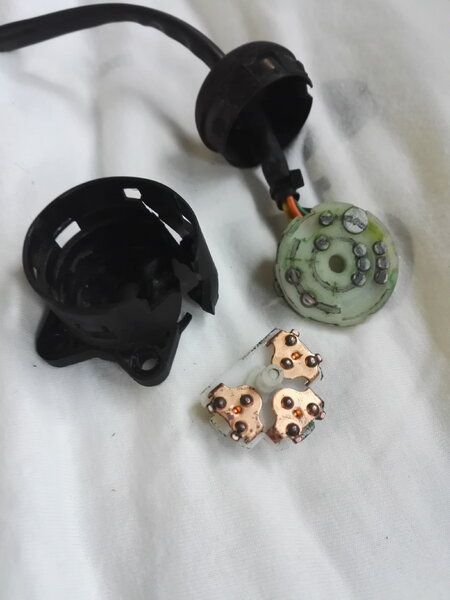
audiomick
Members-
Posts
2,497 -
Joined
-
Last visited
-
Days Won
50
Content Type
Profiles
Forums
Events
Gallery
Community Map
Everything posted by audiomick
-
Yes, it was definitely tampered with. As I wrote, I just don't know whether the damage was already done when I took the battery out on the assumtion that it was flat, or whether the damage was done after that. The bike stood on the on-street parking bay all night. There were other signs that someone had messed around with it. The left mirror was pointing off at an odd angle, the lights were on high-beam (definitely not switched by me...). Someone had a good fiddle with it. I'm going around to the garage now to have a closer look at the damage...
-
Turns out the battery may not have been flat. I can't say for sure. I went in today, got the battery out and re-installed it. As I was about to try and start it, I noticed the contact plate of the ignition switch hanging out of the left side of the fairing. I don't know if the bike was tampered with before I tried to start it last night, or during the night after I took the battery out and put it on the charger in the store room. Anyway, I found the bit with the spring loaded copper contacts on it lying inside the fairing. With the help of a copious amount of electricians tape, I was able to make a contact, start the bike, and ride it to my garage. It is in there now, and I hope to be able to get it fixed fairly soon. First thing is to have a good look at the damage, then do some research into what parts and if they are available. As far as I could tell by squinting in under the instruments, the plastic cylinder that the whole business lives in is broken. I was too dispirited to have a closer look after I got it into the garage. Needless to say, I am not amused. Edit: the first results of an internet search are not very encouraging.... https://motorize.de/de/368980-moto-guzzi-v11-sport-2003-schlosssatz-tankdeckel-schlsser-zndschloss.html
-
Ran the battery flat. I rode it "the long way around" to work today. "Work" is in the Leipzig Opera House. As I was taking off my helmet, the Opera Director came past on his way to work. He greeted me, and commented on the bike and so on. As a result, I wasn't concentrating when I turned the key to engage the parking lock. I reckon I turned it all the way to "parking lights". When I tried to start it to go home after work, nothing. Fortunately: There are some tools under the seat. This occurred to me in time to stop me from just going home in a huff, and I took the battery out. I was all set to take the battery home on the tram, carrying the helmet and far too warmly dressed. Then it occurred to me that we (the sound and video department of the Opera House), by lucky coincidence related to a production that is running at the moment, have a CTEK battery charger set up ready to go in our storeroom. And I could leave the helmet and the excess clothing in my locker at work. So I went back in, plugged the battery onto the charger, and left the excess baggage in my locker. Hopefully, when I go back in tomorrow around midday after the forecast rain has stopped, I'll be able to put the battery back in and ride the bike home. And hopefully, the battery is not defunct. Also, I noticed when taking the battery out that the - terminal wasn't done up particularly tightly. The bonus would be that that is the cause of the starting problems it has been having. We'll see. More likely, I'll have to get a new battery, I reckon.
-
Another forlorn Guzzi owner looking for a V11 Le Mans Tenni
audiomick replied to Guzzi 1947's topic in Wanted
I could only find this one: https://www.ebay-kleinanzeigen.de/s-anzeige/guzzi-v11-le-mans-tenni/2394898251-305-7973 Looks ok, but a bit pricey, I reckon. -
The difference between "clearance" and "no clearance" is less than 1 mm. But the tip is good. I'll see if I can measure the clearance somehow. I'm thinking of it because one of the bolts holding the relay sockets to the frame doesn't have any clearance.
-
That indicates that one should avoid over tightening those screws, doesn't it?
-
Watches, clocks, and . . . sundials!
audiomick replied to p6x's topic in Special place for banter and conversation
With brass screws, of course. -
The only thing that gives me cause to stop and think is the height at 26mm. I gather the originals were 21mm. The ones in mine at the moment are 22mm. . Has anyone got the Picker items in a V11, and can comment on the clearance to the seat or lack thereof?
-
Quite rightly. Regardless of how much current is going through the contact, if it starts bouncing there wil be "constant" arcing across the contact. That is, over time, the end for the relay.
-
Yes, I know. I can see people's eyes glazing over as they read from here. Nevertheless, a quick word about coil resistance and power. I spoke once again to my electronic technician colleague. He confirmed that a solid state circuit providing the voltage to activate the coil of a relay would indeed be set up for a specific resistance, but the tolerance is likely to be very high. As long as the replacement has a resistance "in the same order of magnitude" it should be fine. He also confirmed the importance of a strong contact, particularly in a high vibration environment like in a motorcycle. Therefore docc's preference for a "stronger" coil is justified.
-
Regarding that: the spec. sheets refer to 10 ~ 40 Hz. . I thought that was probably to low to be relevant, but it turns out I was wrong. 2.4000 rpm is equivalent to 40 Hz, i.e. 2400(rpm )/ 60(seconds per minutes)=40 (Herz=cycles per second). So the stated frequency range is relevant to the lower part of the real world rev. range of the motor. Apart from that, other pennies have been dropping in the course of today. Regarding the coil resistance, which I hadn't done all that much till now: coil resistance is tied up with coil power, which docc has mentioned a couple of times. The corelation is in the formulae. Coil power can be calculated with the formula P = VI https://en.wikipedia.org/wiki/Electric_power and the current in the coil with I=V/R https://en.wikipedia.org/wiki/Electric_current The Picker spec. sheet quotes coil resistance at 120 Ohm for the 1.2 W version, as does the spec. sheet for the CIT relay. That gives us a current in the coil of 12V divided by 120 Ohm = 0.1 Ampere. So, negligible. Therefore I would assume that the coil power (apart from holding the relay open/closed under mechanically difficult conditions like excessive vibration) or coil resistance (looking at it from the other side) is pretty much irrevlevant. Mechanical switches such as the ignition switch, light switch, and so on, can certainly handle that sort of current. The exception might be the relay that is switched by the ECU. The switching voltage is generated by the ECU, a solid state circuit (i.e. probably a transistor). Such things are set up to expect a specific resistance at the othe end of the wire. If the resistance at the other end is too high, not enough current can flow (I=V/R, and V is constant). If the resistance is not high enough, too much current could flow, and the output stage of the ECU might shit itself. Therefore, I would not like to see the coil resistance /coil power for the specific relay that is switched by the ECU deviate to much from the specs of the original relay. Otherwise, I think that (coil resistance) is a spec. that doesn't have to interest us too much.
-
Splitting hairs: the manufacturer would most likely say that the spec. sheets support the claimed rating. We can only trust the spec. sheets, or not. Nevertheless, they both seem to be at the top of the range that I have seen for "high current" relays. "Bigger" ones, i.e. 40 A. or more, seem to jump to a 9.3 mm blade on the load connections (30 and 87/ 87a), so they wouldn't fit in the sockets. I like the Picker a little better, because the NC contact claims a higher rating (25A. vs 20A, both @ 14V). The "vibration resistance" spec has a higher number next to it (2.7mm double amplitude), but I don't know if that is relevant to our application.
-
That is probably the pertinent point. A "middle class" relay may well be "good enough" when the rest of the circuit is well maintained. When everything else is marginal, the problem is going to show up some where.
-
No. It's nit-picking, but it's also only about the definition of "nominal". In the accepted jargon, bikes and cars (nearly always) have a "12V electrical system". Look here: https://www.collinsdictionary.com/dictionary/english/nominal one talks about a "12V system" even though everyone knows the real voltage is not 12V. Therefore, per Definition, 12V is the nominal voltage. Nevertheless Yes. According to my limited knowledge of electrics, absolutely correct. and... Yes. An electrical part getting hotter than normal is an almost certain sign that a resistance is increasing or increased. By that I don't mean the component "resistor", but rather the resistance, for instance, across the contacts. i.e. if the relay starts getting hotter than it normally should be, it is a fair assumption that the contacts might be going bad = replace it. Edit: I suppose a bad contact in or to the socket could also make the relay heat up. That would be worth a look at before spending money on a new relay. another Edit: if a particular relay is always running a bit warmer than the others, then of course one could consider a higher rated relay in that position. One with a higher rating would most likely run cooler. The question is, is the relay in question running too hot? The temperatures you reported in that linked post, docc, don't look "too hot" to me. Highest reported temp. 147° F = just short of 64°C. That is still 20°C below the "max. temp." specs of typically 85°C that appear on various spec. sheets. So probably ok.
-
Thanks docc. So, terminal to the back of the bike, and positive on the left from the rider's perspective.
-
Daniel Graig. The old, familiar story, but in "modern". I read about that in another forum. Apparently the hazard warning goes off under very heavy braking, but can't be switched on manually. Curious...
-
Yes. Don't know where it goes yet, I'll have to have another look to find that out. I assumed it was standard something or other, as the pinkish sleeve on it is the same as the other thick cable that is connected to the + terminal. Might be a mod, though, I suppose. PS: can someone post a photo of a standard, or near standard, battery? I gather mine is not in the same orientation as a standard one. Knowing which way around it was mounted originally, and where the + and - terminals were, might help me understand what has been done to the wiring on mine.
-
I find it interesting that they quote "Maximum Switching Power 350 W" (power rather than current). Given that, they are a little inconsistent (I think) by not quoting a voltage for the maximum continuous current. Note that there are voltages given in the contact ratings. I consider it impossible that the maximum current could be the same at any voltage, but I might be wrong. That they specify maximum switching power allows the assumption that a voltage other than 12V could be switched by the relay. Further up I linked to this: https://en.wikipedia.org/wiki/Electric_power where we can see that p = VI, i.e. power is the product of Volts x current. We are talking about motorcycles with a nominal (there's that word again...) voltage in the wiring system of 12 V. That means that, according to the specification of 350W switching power, the relay can safely switch 29,17 A. at the nominal 12 V. As we all know, in a healthy electrical system on a motorcycle the voltage is more like 12.8 V or so, so the real world current that can be safely switched is slightly lower. That this figure is lower than the the continuous carrying current should be no surprise, as we had already established further up that it is generally the case that the "carry" current is higher than the "switching" current. If we consider other voltages and the specification of maximum switching power, then the relay can safely switch anything between 350 A @ 1V to 1A @ 350V. Theoretically, at least. Some more maths: Take the spec 1C : NO 30A@ 14V DC. 30x14= 420 Watt. go back to the nominal 12V in the electrical system: 420 / 12 = 35 which is the stated continous current. Once again, I think they are a bit inconsistent in those specs, i.e. jumping around with the voltages they are assuming, but I'm guessing. Anyway, on the basis of those specs I would assume a safe switching current on a motorcycle of around 30 A., and a safe continuous (carrying) current of 35 A as stated on the spec sheet. If the relay gets really hot, those figures will both be lower, but I as already mentioned, I don't think the relays are likely to get that hot on a V11.
-
Moto Guzzi V100 Sport Tourer: water cooled, 120 HP (26th of August 2021)
audiomick replied to p6x's topic in Newer models
I've seen quite a number of you tube videos that were claiming to be "sound checks" for some vehicle or other. The idea that one can get a realistic idea of what something sounds like from a video that was recorded by a gopro, or better still a mobile telephone, that was then posted on the internet to be listened to on computer speakers, or maybe even a mobile telephone, is simply absurd. -
I had a very good look at all of that, and I'm certain that the cable from the + terminal is not connected to the bolt behind the battery. I'll have another look now that you have all made me uncertain, but... What I saw was the "monstercable" with the connector with the yellow insulation that is connected to the - terminal definitely goes to that bolt. On the photo, one can see the same type of terminal at the bolt. That is the other end of that wire. There is also a connector on there that seems to be part of the original loom. Also, there is a cable that goes to the - side of the accessory socket that is installed in the fairing. If a cable from the + terminal were also connected to that bolt, the battery must already be short circuited to death. It isn't, so I am assuming I followed the wires correctly.
-
a P.S. to the last post: I spoke to my electronic technician colleague again today. He confirmed those assumptions, and went on to say that for our application, pretty much only the stated switching current is directly relevant.
-
-
Moto Guzzi V100 Sport Tourer: water cooled, 120 HP (26th of August 2021)
audiomick replied to p6x's topic in Newer models
That calling a you tube video a "sound check" is completely absurd. The mufflers look pretty tidy, though. -
Days like this....
audiomick replied to guzzler's topic in Special place for banter and conversation
Almost always, in my experience.







